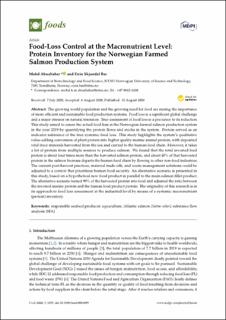| dc.contributor.author | Abualtaher, Moh'd Hasan Moh'd | |
| dc.contributor.author | Bar, Eirin Marie Skjøndal | |
| dc.date.accessioned | 2020-08-18T09:31:22Z | |
| dc.date.available | 2020-08-18T09:31:22Z | |
| dc.date.created | 2020-08-11T19:22:16Z | |
| dc.date.issued | 2020 | |
| dc.identifier.citation | Foods. 2020, 9 (8) | en_US |
| dc.identifier.issn | 2304-8158 | |
| dc.identifier.uri | https://hdl.handle.net/11250/2672750 | |
| dc.description.abstract | The growing world population and the growing need for food are raising the importance of more efficient and sustainable food production systems. Food loss is a significant global challenge and a major stressor on natural resources. True assessment of food loss is a precursor to its reduction. This study aimed to assess the actual food loss in the Norwegian farmed salmon production system in the year 2019 by quantifying the protein flows and stocks in the system. Protein served as an indicator substance of the true systemic food loss. This study highlights the system’s qualitative value-adding conversion of plant protein into higher quality marine animal protein, with deposited vital trace minerals harvested from the sea and carried to the human food chain. However, it takes a lot of protein from multiple sources to produce salmon. We found that the total invested feed protein is about four times more than the harvested salmon protein, and about 40% of that harvested protein in the salmon biomass departs the human food chain by flowing to other non-food industries. The current post-harvest practices, material trade-offs, and waste management solutions could be adjusted to a context that prioritizes human food security. An alternative scenario is presented in this study, based on a hypothetical new food product in parallel to the main salmon fillet product. The alternative scenario turned 99% of the harvested protein into food and adjusted the ratio between the invested marine protein and the human food product protein. The originality of this research is in its approach to food loss assessment at the industrial level by means of a systemic macronutrient (protein) inventory. | en_US |
| dc.language.iso | eng | en_US |
| dc.publisher | MDPI | en_US |
| dc.rights | Navngivelse 4.0 Internasjonal | * |
| dc.rights.uri | http://creativecommons.org/licenses/by/4.0/deed.no | * |
| dc.title | Food-Loss Control at the Macronutrient Level: Protein Inventory for the Norwegian Farmed Salmon Production System | en_US |
| dc.type | Peer reviewed | en_US |
| dc.type | Journal article | en_US |
| dc.description.version | publishedVersion | en_US |
| dc.source.volume | 9 | en_US |
| dc.source.journal | Foods | en_US |
| dc.source.issue | 8 | en_US |
| dc.identifier.doi | https://doi.org/10.3390/foods9081095 | |
| dc.identifier.cristin | 1822856 | |
| dc.description.localcode | This is an open access article distributed under the Creative Commons Attribution License which permits unrestricted use, distribution, and reproduction in any medium, provided the original work is properly cited. | en_US |
| cristin.ispublished | true | |
| cristin.fulltext | original | |
| cristin.qualitycode | 1 | |

